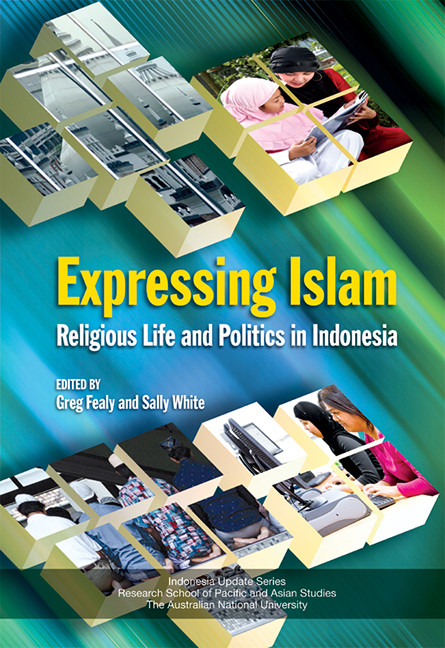Book contents
- Frontmatter
- Contents
- List of Figures and Tables
- List of Contributors
- Acknowledgments
- Glossary
- Map
- 1 Introduction
- PART I EXPRESSING PERSONAL PIETY
- PART II POLITICAL, SOCIAL AND LEGAL EXPRESSIONS OF ISLAM
- 7 Religion, Politics and Social Dynamics in Java: Historical and Contemporary Rhymes
- 8 Islam and Gender in Contemporary Indonesia: Public Discourses on Duties, Rights and Morality
- 9 Online Fatwa in Indonesia: From Fatwa Shopping to Googling a Kiai
- 10 Regional Sharia Regulations in Indonesia: Anomaly or Symptom?
- 11 ‘As Long as It's Halal’: Islamic Preman in Jakarta
- 12 Indonesian Terrorism: From Jihad to Dakwah?
- PART III THE ISLAMIC ECONOMY
- Index
- Indonesia Update Series
- Plate section
12 - Indonesian Terrorism: From Jihad to Dakwah?
from PART II - POLITICAL, SOCIAL AND LEGAL EXPRESSIONS OF ISLAM
Published online by Cambridge University Press: 21 October 2015
- Frontmatter
- Contents
- List of Figures and Tables
- List of Contributors
- Acknowledgments
- Glossary
- Map
- 1 Introduction
- PART I EXPRESSING PERSONAL PIETY
- PART II POLITICAL, SOCIAL AND LEGAL EXPRESSIONS OF ISLAM
- 7 Religion, Politics and Social Dynamics in Java: Historical and Contemporary Rhymes
- 8 Islam and Gender in Contemporary Indonesia: Public Discourses on Duties, Rights and Morality
- 9 Online Fatwa in Indonesia: From Fatwa Shopping to Googling a Kiai
- 10 Regional Sharia Regulations in Indonesia: Anomaly or Symptom?
- 11 ‘As Long as It's Halal’: Islamic Preman in Jakarta
- 12 Indonesian Terrorism: From Jihad to Dakwah?
- PART III THE ISLAMIC ECONOMY
- Index
- Indonesia Update Series
- Plate section
Summary
In this chapter, I will try to predict the future evolution of the jihadi movement in Indonesia. Jemaah Islamiyah (JI) has been the best known of several jihadi organisations operating in Indonesia and neighbouring countries, and my focus will largely settle on it. The task is a hazardous one, not least because, in several respects, the conditions facing jihadism now differ vastly from when JI was set up as a successor to Darul Islam, which continued to exist, though shorn of some of its membership, after JI emerged in 1993. In the decade and a half between 1985 and 2000, the jihadi movement was free to expand with relative impunity, the more so as JI leaders were secure in their self-imposed exile in Malaysia. Now, however, confronting a vigilant police apparatus deployed by a government for which combating terrorism has high priority, Indonesian jihadis seem to be no nearer to achieving their goals of first an Islamic state and then a caliphate embracing several Southeast Asian lands. Many have paid heavily, through prison sentences or death, for the violence they or their comrades have wreaked over the last eight years. The likeliest outcome for the near future is that veteran jihadis will fall back on dakwah, or spreading peacefully their understanding of Islam, while some of their juniors, bound together in small cells or even acting individually, continue to carry out violence. But, as we will see, drawing a boundary between dakwah and jihad will be no easy task.
YUDHOYONO 'S BALANCE SHEET
Susilo Bambang Yudhoyono's government has won high praise in the West for its thoroughness in fighting terrorism. Several major terrorists have been arrested or killed since it took office, including Azhari, the late Malaysian bomb maker, Zuhroni, JI's latest commander (amir), and Abu Dujana, a former JI military commander. There have been no terrorist attacks against foreigners in Indonesia for over two years. Sectarian conflict, which gave jihadis a stage for training and combat experience in Maluku and Central Sulawesi several years ago, has now largely been contained. The Indonesian police, the main counterterrorist agency, have toyed with various creative approaches to ‘deradicalising’ jihadis, and several former JI members, such as the one-time territorial division head, Nasir Abas, and the repentant Bali bomber, Ali Imron, have come to the fore as facilitators or role models for this program.
- Type
- Chapter
- Information
- Expressing IslamReligious Life and Politics in Indonesia, pp. 211 - 226Publisher: ISEAS–Yusof Ishak InstitutePrint publication year: 2008

